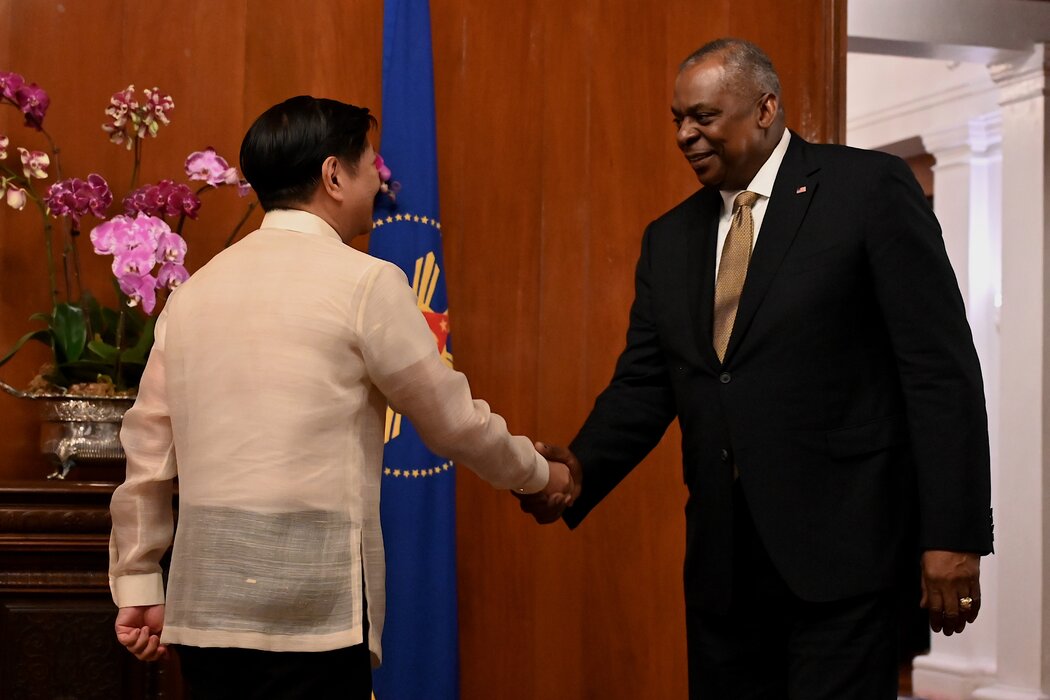For a Filipino like me who grew up under the dictatorship of Ferdinand Marcos Sr., the news of the expanded U.S. military presence in the Philippines was dizzying and traumatic.
Last week in Manila, US Secretary of Defense Lloyd Austin shook hands with the despot’s son, Philippine President Ferdinand Marcos Jr., smiling like a tragic day in “Groundhog Day” . In this way, the Filipinos found themselves facing not only yet another Marcos president, but another quiet occupation by the US military under the guise of East Asian security.
Thirty years ago, the Philippine Senate ended the permanent presence of U.S. troops . But according to Austin, China’s growing influence in the region makes a redeployed U.S. military presence crucial.
The United States has long been attracted by the Philippines’ proximity to China. For Filipinos, this is a curse.
After the Spanish-American War, the U.S. annexed the islands, once colonized by Spain , in 1898 , giving American goods a foothold for their real benefit: a huge market in China. As Senator Albert Beveridge of Indiana said in 1900 , “The Pacific Ocean is our ocean… Where shall we find someone to consume our surplus goods? Geography answers. China is our natural customer.” ’” He said the Philippines provided the United States with a “base to access the entire gateway to the East.”
From 1899 to 1902, Filipinos who fought for their country’s freedom stood no chance against the U.S. military. More than 200,000 Filipinos were killed, or died of famine and disease, during the Philippine-American War, a conflict that has been likened to genocide , and the U.S. war against Native Americans. What followed was a nation created “in our image,” as the American historian Stanley Carnot described it.
For greed and geopolitical reasons, the US made it a policy to consolidate the Philippine oligarchy as it strengthened US control. Following the feudal model established by the Spanish, a few powerful families prospered on the trajectory of neocolonialism in the United States, consolidating land, resources, and power during the Cold War and into the current era of China’s global rise.
Scenes representing the US-Philippines’ enduring relationship are etched in our collective memory like trauma: Imelda Marcos applauds Richard Nixon at the piano , Mrs. Marcos laughs with Gerald Ford , Marcos Sr. dances intimately with Nancy Reagan . American leaders sang and danced with Marcos Sr., who enforced martial law from 1972 to 1981—that was my childhood. The tyrant thrived during the Cold War, using a U.S.-funded counterinsurgency campaign against Communists to consolidate power. He imprisoned, tortured, or killed thousands of people , and stole an estimated $5 billion to $10 billion , until a popular uprising in 1986 exiled him and his family to Hawaii.
Chinese predation is another nightmare for the Philippines. Austin said the reason for the U.S. return to the Philippines was that China continued to advance its ” illegal claims ” in parts of the South China Sea , which the Philippines also claims to have sovereignty over. There are fears that China could invade Taiwan, which is just 150 kilometers from the northernmost island of Ibayate in the Philippines . The Philippines is not the only Southeast Asian nation concerned about being drawn into the firefight .
China’s encroachment on the South China Sea – including building military installations – has drawn global condemnation. In 2016, an international tribunal ruled in the Philippines’ favor, rejecting China’s maritime claims. However, then Philippine President Rodrigo Duterte expressed his goodwill to Beijing and hoped to obtain Chinese investment , so he ignored the ruling of the arbitral tribunal and expressed obedience to China. ( “I need China,” he once declared. “I just love Xi Jinping.” ) He also regularly slanders the United States. However, like all Filipino oligarchs, he also dances with the United States, maintaining a military treaty with Washington.
Duterte, whose mercurial drug war has resulted in thousands of extrajudicial killings, is relieved to leave office. But his successor wasn’t much different. Marcos Jr. won the presidency on a campaign fueled by disinformation and never dismissed his father’s legacy of cronyism and corruption. His 28-year-old son Sandro, a political novice, has been named to a senior leadership position in the Philippine House of Representatives ; Marcos’ cousin, Martin Romualdes, is the House speaker. They were among the authors of a bill to promote a plan by the new Marcos government to take money from the social security system and inject it into a sovereign investment fund , which has sparked public outcry.
Marcos himself serves as secretary of agriculture, a powerful position. Under his leadership, the prices of basic foodstuffs have soared , with onions recently costing more than meat. The killings and culture of impunity of the drug war continue. Indigenous activists , journalists , human rights defenders and others labeled communists are at risk. Marcos loves to travel on public expense, traveling to Davos with a large entourage . His administration has been opaque about costs. What he did with wasting US military money is well known. Like his father, American support will be used to deflect public criticism.
Duterte and Marcos are exactly the same: their families and cronies have profited from and will continue to do so from U.S. geopolitical and military interests in the Philippines.
With regard to these turbulent histories, President Biden has an opportunity to atone for America. Rep. Susan Wilder of Pennsylvania urged her colleagues to sign the Philippine Bill of Rights , which would suspend security aid to the Philippines “until violence against dissidents stops and accountability for those responsible begins. responsibility.” Wilder and a bipartisan group of lawmakers also called for sanctions against human rights violators in the Philippines.
Until then, the long dance between Washington and Manila continues, repeatedly frightening the Filipino people.
Nytimes
Tags: Philippines




